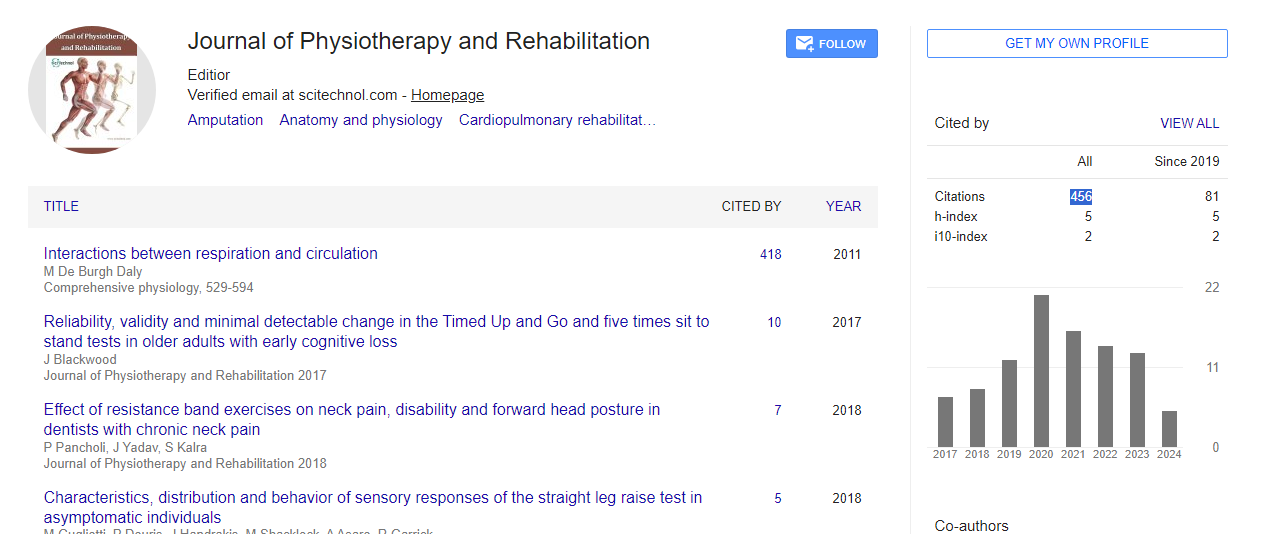Commentary, J Physiother Rehabi Vol: 8 Issue: 1
Injury Prevention and Rehabilitation: Sports Physical Therapy Strategies
Maiec N Stecco*
1Nursing and Physical Therapy Department, University of Leon, Astorga Ave, 24401, Ponferrada, Spain
*Corresponding Author: Maiec N Stecco,
Nursing and Physical Therapy
Department, University of Leon, Astorga Ave, 24401, Ponferrada, Spain
E-mail: stecco@mai.es
Received date: 02 January, 2024, Manuscript No. JPTR-24-134577;
Editor assigned date: 04 January, 2024, PreQC No. JPTR-24-134577 (PQ);
Reviewed date: 18 January, 2024, QC No. JPTR-24-134577;
Revised date: 26 January, 2024, Manuscript No. JPTR-24-134577 (R);
Published date: 02 February, 2024, DOI: 10.4172/JPTR.1000159.
Citation: Stecco MN (2024) Injury Prevention and Rehabilitation: Sports Physical Therapy Strategies. J Physiother Rehabi 8:1.
Description
In the world of sports, injuries are an inevitable part of the game. Whether you're a professional athlete or a weekend warrior, the risk of injury is ever-present. However, with the right approach to injury prevention and rehabilitation, athletes can minimize the likelihood of injuries and recover more quickly when they do occur. Sports physical therapy plays a vital role in this process, employing a range of strategies to keep athletes healthy, strong and performing at their best.
Before diving into prevention and rehabilitation strategies, it's essential to understand the common patterns of sports injuries. While the specific types of injuries may vary depending on the sport, certain patterns emerge across different athletic disciplines. These may include sprains and strains, tendonitis, stress fractures, and overuse injuries. By identifying these patterns, sports physical therapists can tailor their interventions to address the unique needs of each athlete and sport.
One of the primary goals of sports physical therapy is to prevent injuries before they occur. This often begins with education, as athletes learn about proper warm-up and cool-down techniques, the importance of adequate hydration and nutrition, and strategies for maintaining optimal biomechanics and body mechanics during training and competition. Additionally, sports physical therapists work with athletes to develop individualized conditioning programs designed to improve strength, flexibility, balance, and proprioception, all of which are important for injury prevention.
Biomechanics plays a significant role in both the prevention and rehabilitation of sports injuries. Sports physical therapists use advanced techniques such as motion analysis and gait analysis to assess athletes movement patterns and identify any biomechanical imbalances or deficiencies that may predispose them to injury. By correcting these imbalances through targeted exercises, manual therapy, and corrective movement patterns, therapists can help athletes move more efficiently and reduce the risk of injury.
Despite the best prevention efforts, injuries can still occur. When they do, sports physical therapists plays an important role in the rehabilitation process, guiding athletes through a structured program aimed at restoring function, reducing pain, and facilitating a safe return to play. This may involve a combination of therapeutic modalities such as manual therapy, therapeutic exercise, neuromuscular re-education, and modalities like ultrasound or electrical stimulation, depending on the nature and severity of the injury.
Injuries not only affect athletes physically but also psychologically. The psychological impact of injury, including fear of re-injury, frustration, and anxiety, can hinder the rehabilitation process and delay return to play. Sports physical therapists recognize the importance of addressing these psychological factors and provide athletes with the support and encouragement they need to stay motivated and focused throughout the recovery process. This may involve techniques such as goal setting, visualization, relaxation training, and cognitivebehavioral strategies to help athletes maintain a positive mindset and cope with the challenges of injury.
Advancements in technology have revolutionized the field of sports physical therapy, offering new tools and techniques for injury prevention and rehabilitation. From wearable sensors that track movement and biomechanics to virtual reality systems that facilitate movement retraining and motor learning, technology has opened up new possibilities for optimizing athletic performance and recovery. Sports physical therapists stay at the forefront of these innovations, incorporating them into their practice to provide athletes with the most effective and advance care.
Conclusion
In sports physical therapy plays a vital role in both the prevention and rehabilitation of sports injuries. By employing a comprehensive approach that includes education, conditioning, biomechanical analysis, rehabilitation, psychological support, and innovative technology, sports physical therapists help athletes stay healthy, recover from injuries more quickly, and perform at their best. As our understanding of sports medicine continues to evolve, so too will the strategies and techniques used to keep athletes safe, resilient, and thriving in their sport.
 Spanish
Spanish  Chinese
Chinese  Russian
Russian  German
German  French
French  Japanese
Japanese  Portuguese
Portuguese  Hindi
Hindi 